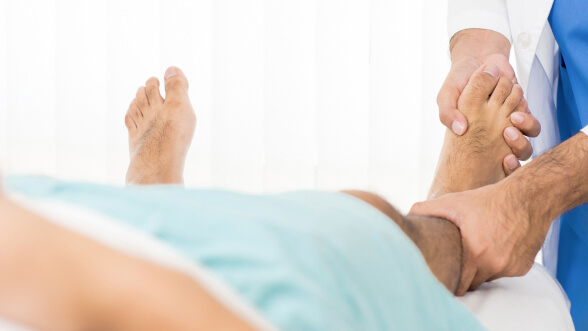
Find a foot care service near you
Use our Australia-wide directory of high-risk foot services to find the right support, in the right location.
NDSS Helpline
If you’re living with diabetes you probably already know you have a higher risk of developing foot problems, which can lead to the amputation of toes, feet or limbs.
The good news is that with early identification and treatment of these problems, you can significantly lower the chance of this happening to you.
People with diabetes may experience changes in their feet quite suddenly. That’s why it is important to check your feet every day. Maybe have a good look every morning when putting your socks on or use a mirror to see under your feet. If you experience any changes, contact your GP or healthcare professional.
Moderate regular exercise is a good idea for everyone! Walking or light, weight-bearing activity is recommended. Be sure to wear appropriate footwear and find an activity you enjoy – walking with friends, riding a bike, a yoga class or water aerobics are a great place to start. Remember to always check your feet for rubs or wounds after exercising.
If you have or have had a foot ulcer, loss of protective sensation or changes to your circulation, limit your weight-bearing exercises. Visit a trained health care professional prior to commencing any new exercise regime.
Use a moisturising cream to keep your skin healthy but don’t put cream between your toes as this could cause problems. The same goes for talcum powder which, when clogged up, can cause dryness. Talk to your healthcare specialist to find the right product for you.
Only wear socks and shoes that fit well and don’t rub against your skin. Get your shoes from a professional and take care that they…
Your local podiatrist can give you more tips.
Always wear shoes when walking or doing any form of physical activity.
Despite the risks that poor-fitting shoes may pose, footwear offers protection that being barefoot or wearing socks on their own do not. For instance, there is an increased risk of stepping on foreign objects and causing injury from stubbing toes.
Check your footwear every time you put them on. Always check the inside of the shoes with your hand to make sure nothing has fallen inside them. Check that nothing has pierced the sole of the shoe. This could be some glass or a tack.
Remember to wear clean socks to wick away sweat and protect against rubs.
Cutting your nails might seem straightforward but if you are living with diabetes cutting your skin can lead to injuries you may not even be aware of. Your healthcare team can tell you if it is safe for you to cut your own toenails.
Cut nails often but not too short, follow the shape of the nail and use nail clippers. If your nails are too hard to cut, a nail file may also be helpful. Visiting a podiatrist for further care and to help treat ingrown or difficult to cut nails is also a good idea.
Washing your feet every day with mild soap and water helps to keep them clean and prevent infections. Remember to dry all areas thoroughly, including between your toes. Do not soak your feet as this can damage the skin.
Eating well and getting regular physical activity will help you reduce your risk of serious foot problems. If you need to find the right physical activity for you or you want to eat well, talk to your healthcare professional or call the NDSS Helpline on 1800 637 700
Quitting smoking can be one of the most difficult, yet rewarding, things a person can do. We know smoking isn’t good for anybody, but for people with diabetes it comes with extra risks.
Smoking makes blood circulation around our bodies more difficult, including in our feet. This increases the risk that any foot wounds and ulcers won’t heal, and can lead to lower limb amputation.
It’s hard to stop, but with the right help and support, you can quit smoking.
Use the resources below, or talk to your health care professional for advice on quitting.
Stable blood glucose levels will help to lower the risk of foot problems. If you are having difficulty keeping your blood glucose levels within your target range talk to your GP, credentialled diabetes educator.
You should have your feet checked once a year by a healthcare professional. This is your chance to have an in-depth check and get answers to all of your questions. Find out about your risk of developing a foot problem and get advice if you should see a specialist or if you need to get your feet checked more regularly.
Foot health check takes approx 2 mins